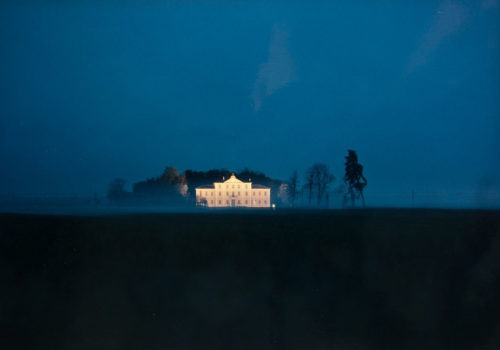The exhibitionis a journey into Luigi Ghirri’s work, through his photos as well as through catalogue proofs, books from his private library, magazines, anonymous photograph collections, postcards and album covers. A complex combination of works and objects (art-objects) which tells his close collaboration with conceptual artists from the Seventies, his cultural and artistic references and his relationship with musicians such as the CCCP group and Lucio Dalla. As a matter of fact, Ghirri was not just a photographer, but also a publisher, a curator, a theorist and a cultural catalyst, who used to dialogue with architects, musicians, writers and artists.
Luigi Ghirri. Thinking Images is a major anthological exhibition featuring over 300 images, mostly vintage prints, showing an overview of a master of Italian photography through three thematic sections: Icons, Landscapes and Architectures. As the curators Francesca Fabiani, Laura Gasparini and Giuliano Sergio explained, “The choice of proceeding by themes rather than by chronological order is a working method typical of Ghirri himself: photography is thought as an unfinished object, a gigantic work in progress”. The displays are accompanied by citations from the writings of Ghirri himself to give an insight into his investigations. Monitors, which are part of the exhibit, let people consult the Luigi Ghirri Digital Library, which includes all the author’s publications not available on the market.
The thematic design of the exhibit stresses the logic of Ghirri’s work by illustrating also the way he looked at, selected, arranged and ordered photos, looking for a new critical approach in conceiving the image: that’s thinking in images, or, according to the title of the exhibition, thinking images.
This is a link to a characteristic of his images, that is “a sort of double look that structures them in a dialectical way” as Franco Vaccari, who curated the critical text of Ghirri’s first exhibition, said. “You can read his photos on a double level of significance”, with a perceptible contrast between the story and the image and an attempt to settle this conflict, thanks to photography and its efficient and flexible code, in order to recognize the signs of the real in their continuous transformation”.
Luigi Ghirri was born in Scandiano in 1943 and died in Roncocesi in 1992 (both near Reggio Emilia). He has been working as a photographer since 1970, developing his approach within the sphere of conceptual art. In 1975 he was on the Photography Year of Time-Life Books; in 1982 he was invited to Photokina in Cologne, where he was one of the “twenty most significant photographers of the 20th century” at the Photographie 1922-1982 exhibition.
Alongside his exhibition activities, he became deeply engaged in a mission of cultural promotion, developing publication projects with his own publishing house Punto & Virgola, and staging exhibits such as Iconicittà (1980), Viaggio in Italia (An Italian Journey, 1984) and Esplorazioni sulla Via Emilia (Explorations along Via Emilia, 1986). At that time he became friends with Gianni Celati, Lucio Dalla, Vittorio Savi and other Italian intellectuals.
In 1985 he worked on the architecture section of the Biennale di Venezia and in 1988 he curated the photography section of the Triennale di Fotografia in Milan. In 1989 he published Paesaggio italiano (Italian Landscape) and II profilo delle nuvole (The Profile of the Clouds), and he started working on Giorgio Morandi’s home-studio.
For this project, the Municipality of Reggio Emilia collaborated with the MAXXI museum in Rome, the Panizzi Library and the Ghirri Estate archive, with works on loan from CSAC in Parma, the National Institute of Graphics in Rome and other private collectors.
EXHIBITION
Luigi Ghirri
Thinking Images. Icons Landscapes Architectures
Until July 28, 2014
Chiostri di San Pietro
Via Emilia San Pietro 44/c
42121 Reggio Emilia
Italy
















